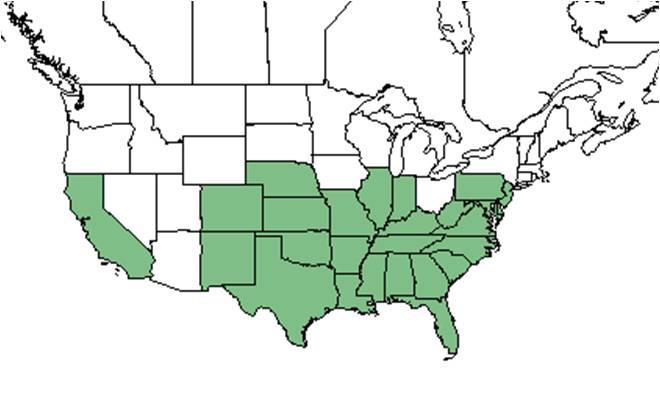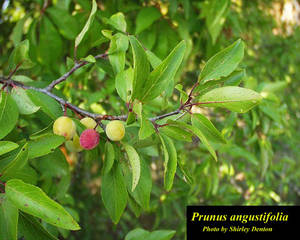Difference between revisions of "Prunus angustifolia"
(→Taxonomic notes) |
|||
| (20 intermediate revisions by 11 users not shown) | |||
| Line 18: | Line 18: | ||
}} | }} | ||
| − | Common name: Chickasaw plum | + | Common name: Chickasaw plum, sandhill plum |
==Taxonomic notes== | ==Taxonomic notes== | ||
| + | Synonyms: none<ref name=weakley>Weakley, A.S. 2020. Flora of the Southeastern United States. Edition of 20 October 2020. University of North Carolina at Chapel Hill, Chapel Hill, North Carolina.</ref> | ||
| + | |||
| + | Varieties: ''Prunus angustifolia'' var. ''angustifolia''<ref name=weakley/> | ||
| + | |||
==Description== | ==Description== | ||
<!-- Basic life history facts such as annual/perrenial, monoecious/dioecious, root morphology, seed type, etc. --> | <!-- Basic life history facts such as annual/perrenial, monoecious/dioecious, root morphology, seed type, etc. --> | ||
| Line 27: | Line 31: | ||
==Ecology== | ==Ecology== | ||
===Habitat=== <!--Natural communities, human disturbed habitats, topography, hydrology, soils, light, fire regime requirements for removal of competition, etc.--> | ===Habitat=== <!--Natural communities, human disturbed habitats, topography, hydrology, soils, light, fire regime requirements for removal of competition, etc.--> | ||
| + | |||
| + | ''P. angustifolia'' has been found in areas with loamy sand, open pine woodlands, ephemeral pond shores, and longleaf-live oak hammocks.<ref name="FSU"> Florida State University Herbarium Database. URL: http://herbarium.bio.fsu.edu. Last accessed: June 2021. Collectors: Loran C. Anderson, Robert K. Godfrey, and D. B. Ward. States and counties: Florida: Jefferson, Lake, Leon, and Taylor.</ref> It is also found in disturbed areas including along hiking trails, old fields, along fences, and along roadsides.<ref name="FSU"/> Associated species: ''Crataegus, Morella, Quercus, Smilax, Pinus, Juniperus, Trifolium, Bromus, Sphenopholiss, Castilleja'', and ''Gelsemium''.<ref name="STAR"> Arkansas State University accessed using Southeastern Regional Network of Expertise and Collections (SERNEC) data portal. URL: http://sernecportal.org/portal/collections/index.php Last accessed: June 2021. Collectors: E.L. Richards. States and Counties: Arkansas. Mississippi.</ref><ref name="AUA"> Auburn University, John D. Freeman Herbarium accessed using Southeastern Regional Network of Expertise and Collections (SERNEC) data portal. URL: http://sernecportal.org/portal/collections/index.php Last accessed: June 2021. Collectors: G. Gil. States and Counties: Alabama: Russell.</ref><ref name="BRIT"> Botanical Research Institute of Texas, Philecology Herbarium accessed using Southeastern Regional Network of Expertise and Collections (SERNEC) data portal. URL: http://sernecportal.org/portal/collections/index.php Last accessed: June 2021. Collectors: Monique Reed. States and Counties: Texas: Midland.</ref> | ||
| + | |||
===Phenology=== <!--Timing off flowering, fruiting, seed dispersal, and environmental triggers. Cite PanFlora website if appropriate: http://www.gilnelson.com/PanFlora/ --> | ===Phenology=== <!--Timing off flowering, fruiting, seed dispersal, and environmental triggers. Cite PanFlora website if appropriate: http://www.gilnelson.com/PanFlora/ --> | ||
| − | ===Seed dispersal=== | + | ''P. angustifolia'' has been observed flowering in February and March.<ref>Nelson, G. [http://www.gilnelson.com/ PanFlora]: Plant data for the eastern United States with emphasis on the Southeastern Coastal Plains, Florida, and the Florida Panhandle. www.gilnelson.com/PanFlora/ Accessed: 13 DEC 2016</ref> |
| − | ===Seed bank and germination=== | + | <!--===Seed dispersal===--> |
| − | ===Fire ecology=== <!--Fire tolerance, fire dependence, adaptive fire responses--> | + | <!--===Seed bank and germination===--> |
| + | <!--===Fire ecology===--> <!--Fire tolerance, fire dependence, adaptive fire responses--> | ||
| + | |||
===Pollination=== | ===Pollination=== | ||
| − | + | ''Prunus angustifolia'' has been observed at the Archbold Biological Station to host bees from the Apidae family such as ''Bombus impatiens,'' and ''Epeolus zonatus'', as well as plasterer bees from the Colletidae family such as ''Colletes brimleyi,'' and ''Hylaeus confluens'', sweat bees from the Halictidae family such as ''Agapostemon splendens, Augochlora pura, Lasioglossum pectoralis,'' and ''L. placidensis'', and wasps from the Vespidae family such as ''Pachodynerus erynnis, Parancistrocerus salcularis rufulus,'' and ''Zethus slossonae''.<ref name="Deyrup 2015">Deyrup, M.A. and N.D. 2015. Database of observations of Hymenoptera visitations to flowers of plants on Archbold Biological Station, Florida, USA.</ref> Additionally, ''P. angustifolia'' has been observed to host bees from the Andrenidae family such as ''Andrena barbara'', ''A. bisalicis'', ''A. dunningi'', ''A. erythrogaster'', and ''A. miserabilis'', as well as bees from the Apidae family such as ''Epeolus zonatus'', ''Habropoda laboriosa'', ''Xylocopa micans'', and ''X. virginica'', plasterer bees such as ''Colletes thoracicus'' (family Colletidae), and sweat bees from the Halictidae family such as ''Lasioglossum cinctipes'', ''L. hitchensi'', and ''L. illinoense''.<ref>Discoverlife.org [https://www.discoverlife.org/20/q?search=Bidens+albaDiscoverlife.org|Discoverlife.org]</ref> | |
| + | <!--===Herbivory and toxicology===<!--Common herbivores, granivory, insect hosting, poisonous chemicals, allelopathy, etc--> | ||
| + | <!--===Diseases and parasites===--> | ||
| − | + | ==Conservation, cultivation, and restoration== | |
| − | + | ==Cultural use== | |
| + | The plum fruit has long been eaten fresh or used in pies, jellies, sauces, and dried fruit.<ref> Fernald, et al. 1958. Edible Plants of Eastern North America. Harper and Row Publishers, New York.</ref> | ||
| − | + | ==Photo Gallery== | |
| − | + | <gallery widths=180px> | |
| − | + | File: Prunus_angusti3_S-Denton_ISB-AtlasPlant_Fruit.jpg | <center> Fruit of ''Prunus angustifolia'' <P> Photo by Shirley Denton (Copyrighted, use by photographer’s permission only), </p> [http://www.florida.plantatlas.usf.edu/Default.aspx Atlas of Florida Vascular Plants] </gallery> | |
| − | |||
| − | |||
| − | |||
| − | |||
| − | |||
==References and notes== | ==References and notes== | ||
| − | |||
Latest revision as of 11:15, 14 July 2023
| Prunus angustifolia | |
|---|---|

| |
| Photo by Shirley Denton (Copyrighted, use by photographer’s permission only), Atlas of Florida Vascular Plants | |
| Scientific classification | |
| Kingdom: | Plantae |
| Division: | Magnoliophyta - Flowering plants |
| Class: | Magnoliopsida – Dicotyledons |
| Order: | Rosales |
| Family: | Rosaceae |
| Genus: | Prunus |
| Species: | P. angustifolia |
| Binomial name | |
| Prunus angustifolia Marshall | |

| |
| Natural range of Prunus angustifolia from USDA NRCS Plants Database. | |
Common name: Chickasaw plum, sandhill plum
Contents
Taxonomic notes
Synonyms: none[1]
Varieties: Prunus angustifolia var. angustifolia[1]
Description
A description of Prunus angustifolia is provided in The Flora of North America.
Distribution
Ecology
Habitat
P. angustifolia has been found in areas with loamy sand, open pine woodlands, ephemeral pond shores, and longleaf-live oak hammocks.[2] It is also found in disturbed areas including along hiking trails, old fields, along fences, and along roadsides.[2] Associated species: Crataegus, Morella, Quercus, Smilax, Pinus, Juniperus, Trifolium, Bromus, Sphenopholiss, Castilleja, and Gelsemium.[3][4][5]
Phenology
P. angustifolia has been observed flowering in February and March.[6]
Pollination
Prunus angustifolia has been observed at the Archbold Biological Station to host bees from the Apidae family such as Bombus impatiens, and Epeolus zonatus, as well as plasterer bees from the Colletidae family such as Colletes brimleyi, and Hylaeus confluens, sweat bees from the Halictidae family such as Agapostemon splendens, Augochlora pura, Lasioglossum pectoralis, and L. placidensis, and wasps from the Vespidae family such as Pachodynerus erynnis, Parancistrocerus salcularis rufulus, and Zethus slossonae.[7] Additionally, P. angustifolia has been observed to host bees from the Andrenidae family such as Andrena barbara, A. bisalicis, A. dunningi, A. erythrogaster, and A. miserabilis, as well as bees from the Apidae family such as Epeolus zonatus, Habropoda laboriosa, Xylocopa micans, and X. virginica, plasterer bees such as Colletes thoracicus (family Colletidae), and sweat bees from the Halictidae family such as Lasioglossum cinctipes, L. hitchensi, and L. illinoense.[8]
Conservation, cultivation, and restoration
Cultural use
The plum fruit has long been eaten fresh or used in pies, jellies, sauces, and dried fruit.[9]
Photo Gallery
Fruit of Prunus angustifolia Photo by Shirley Denton (Copyrighted, use by photographer’s permission only),
Atlas of Florida Vascular Plants
References and notes
- ↑ 1.0 1.1 Weakley, A.S. 2020. Flora of the Southeastern United States. Edition of 20 October 2020. University of North Carolina at Chapel Hill, Chapel Hill, North Carolina.
- ↑ 2.0 2.1 Florida State University Herbarium Database. URL: http://herbarium.bio.fsu.edu. Last accessed: June 2021. Collectors: Loran C. Anderson, Robert K. Godfrey, and D. B. Ward. States and counties: Florida: Jefferson, Lake, Leon, and Taylor.
- ↑ Arkansas State University accessed using Southeastern Regional Network of Expertise and Collections (SERNEC) data portal. URL: http://sernecportal.org/portal/collections/index.php Last accessed: June 2021. Collectors: E.L. Richards. States and Counties: Arkansas. Mississippi.
- ↑ Auburn University, John D. Freeman Herbarium accessed using Southeastern Regional Network of Expertise and Collections (SERNEC) data portal. URL: http://sernecportal.org/portal/collections/index.php Last accessed: June 2021. Collectors: G. Gil. States and Counties: Alabama: Russell.
- ↑ Botanical Research Institute of Texas, Philecology Herbarium accessed using Southeastern Regional Network of Expertise and Collections (SERNEC) data portal. URL: http://sernecportal.org/portal/collections/index.php Last accessed: June 2021. Collectors: Monique Reed. States and Counties: Texas: Midland.
- ↑ Nelson, G. PanFlora: Plant data for the eastern United States with emphasis on the Southeastern Coastal Plains, Florida, and the Florida Panhandle. www.gilnelson.com/PanFlora/ Accessed: 13 DEC 2016
- ↑ Deyrup, M.A. and N.D. 2015. Database of observations of Hymenoptera visitations to flowers of plants on Archbold Biological Station, Florida, USA.
- ↑ Discoverlife.org [1]
- ↑ Fernald, et al. 1958. Edible Plants of Eastern North America. Harper and Row Publishers, New York.
